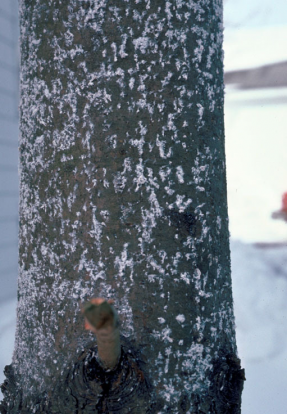Arbor-wellness: Pine Bark Adelgid
Pine trees are common in many of our landscapes. They are decently drought tolerant and bring a little bit of the forest look into our Southern California beach climate. One of the most common pests we find on some of them is a little white cottony pest called Pine Bark Adelgid. This creature is usually found on the bark of several of the pine species we find here. In small numbers they don’t do much damage, but when their population gets high enough, they can weaken a pine tree significantly. Weakened pines are then subject to other insects and diseases that are lethal to them.
When we see a population growing on one or more trees, we usually recommend treating them for a few seasons to reduce the population. If the trees are not healthy, we will also make a recommendation to improve their health. If the tree is otherwise healthy, we won’t have to treat for at least several years. We often use alternate treatments besides spraying for them, which gets better results and we don’t harm the good guys as much.
Adelgids are making a comeback.
One insect that is not talked about much but can become very problematic is a tiny, fuzzy white insect called Adelgid. They feed almost exclusively on conifers, but each type is fairly limited in the number of different tree types it feeds on. They feed on the sap and weaken the trees. When populations are high enough, they will eventually kill the tree, especially hemlocks.
Hemlock Woolly Adelgid
These feed on the needles and small twigs of hemlock tree, forming masses of white cottony spots on hemlocks. They are most prevalent on Eastern hemlock trees and are less of a problem on the Western varieties of this tree.
Pine Bark Adelgid
Most common on thin barked pine trees. They tend to cover the bark close to where branches extend from the trunk, but can fill the entire trunk when the population builds up, creating an almost snow-like affect on the trunk. These adelgids weaken the tree when present in large numbers, but are often not fatal. They tend to favor stressed tress, so maintaining healthy pine trees goes a long way to keeping this insect in check.
Cooley Spruce Gall Adelgid
They are found on Colorado blue spruce, Douglas fir, and Englemann and Sitka spruce. They feed at the tips of small twigs and form a unique looking gall. Once they mature and leave, the gall turns brown and dies, leaving tips of the tree looking unsightly. Rarely do they need treatment, but can be warranted when the population is high.
Balsam Woolly Adelgid
This tiny sucking insect was introduced to North America from Europe. It is a serious pest of true firs in forests and landscape, and in Christmas tree production. Balsam woolly adelgid feeds on the stems of true firs. White or grayish masses of eggs or newly hatched purplish-black insects can be found on the twigs, branches, or trunk. Heavy adelgid infestations may cover the entire trunk. The feeding insects cause the tree to form swollen, knob like areas at nodes and tips of infested branches. Adelgid infestations weaken trees, cause foliage to become sparse, and can kill trees. This is a serious pest in the forest and common on most firs in landscaped areas. Balsam fir and subalpine fir are particularly susceptible. There are two to four generations per year.
We can help you determine if adelgids are a problem on your hemlocks, pines, firs or other conifers.







